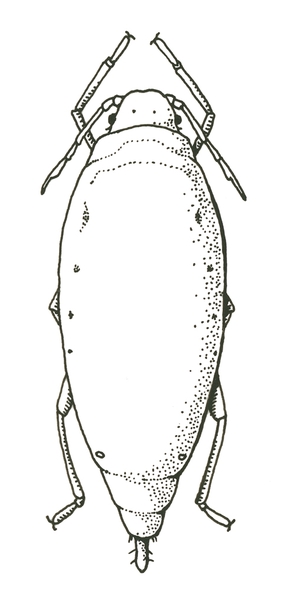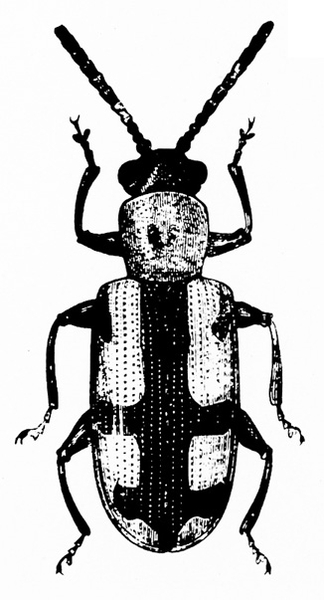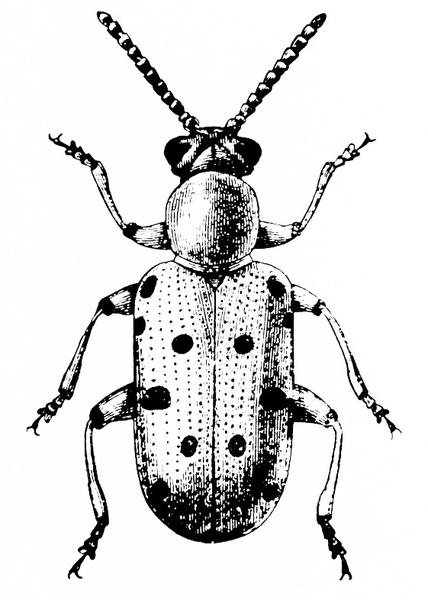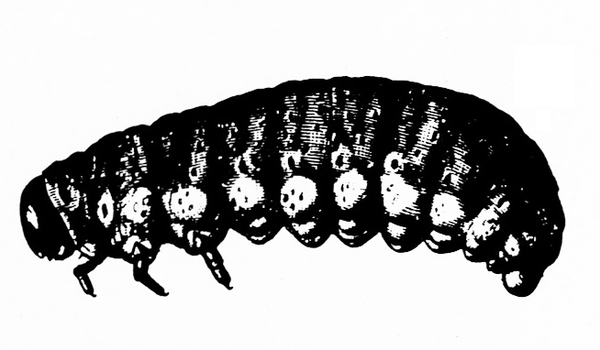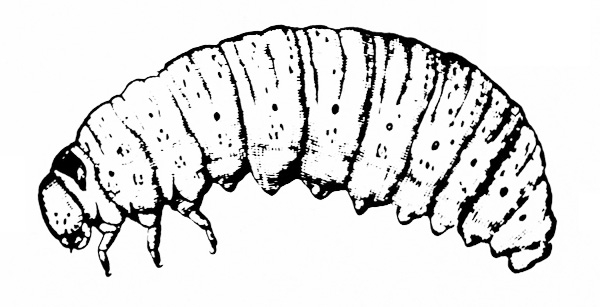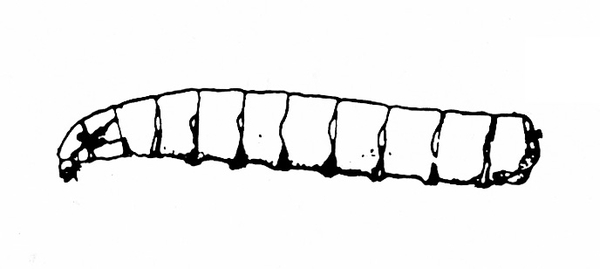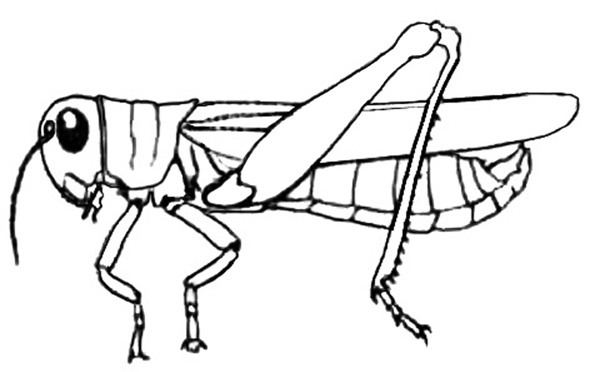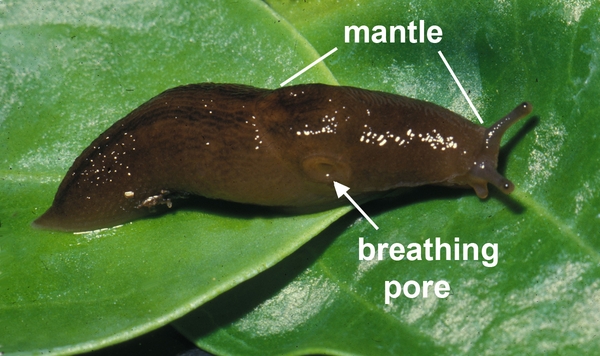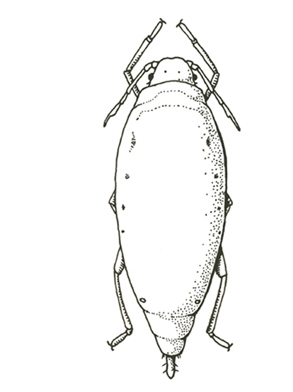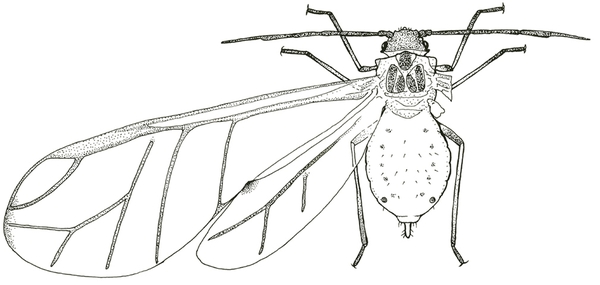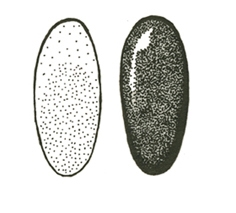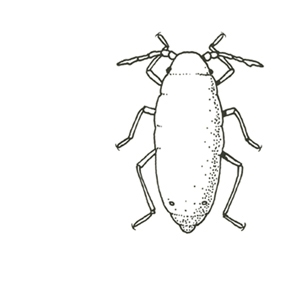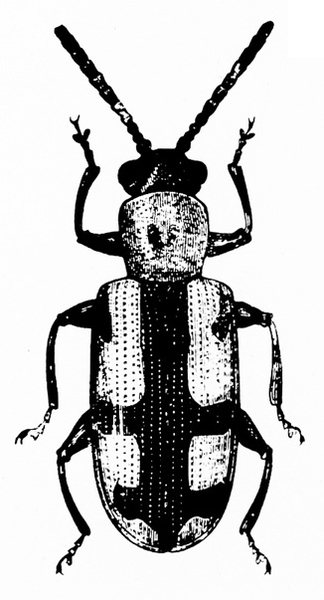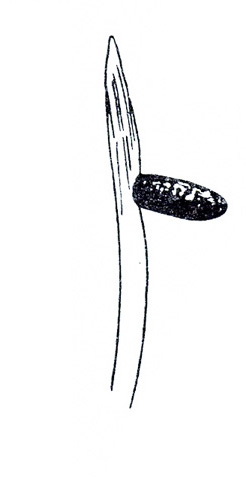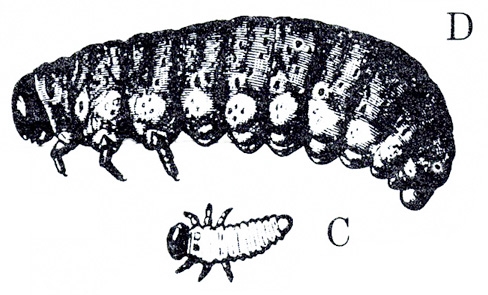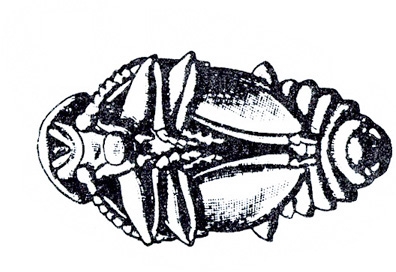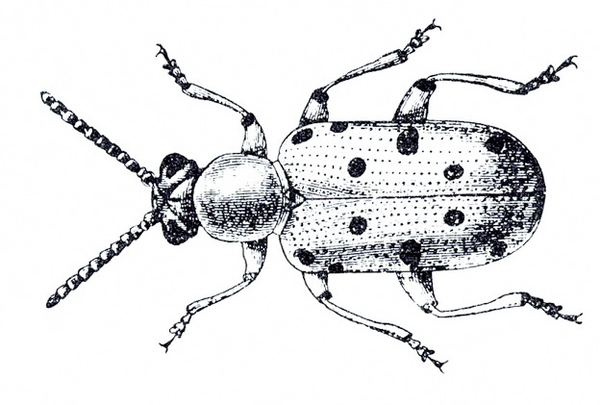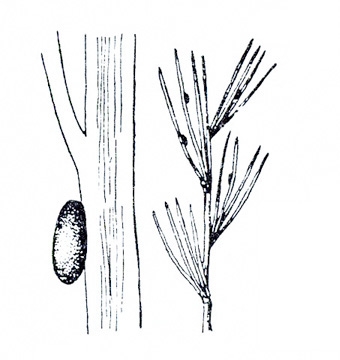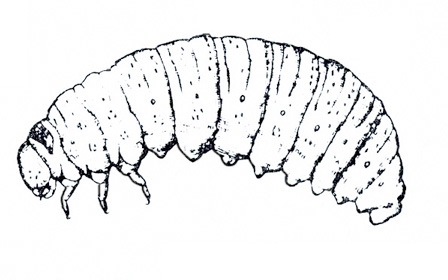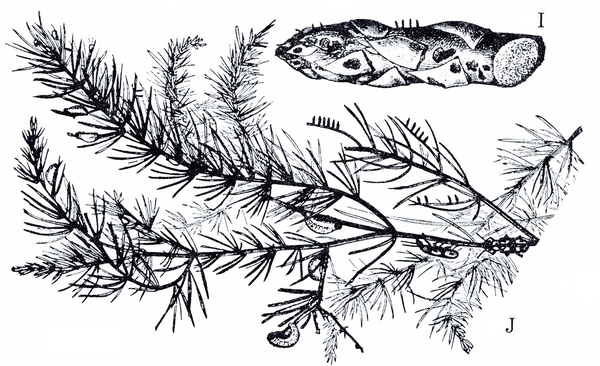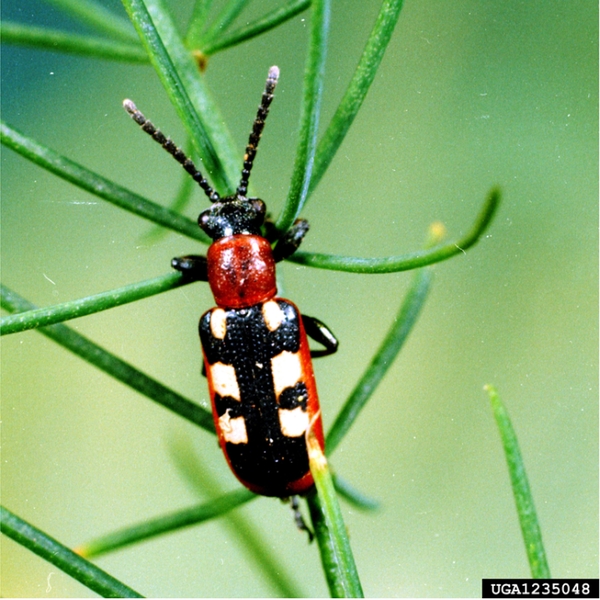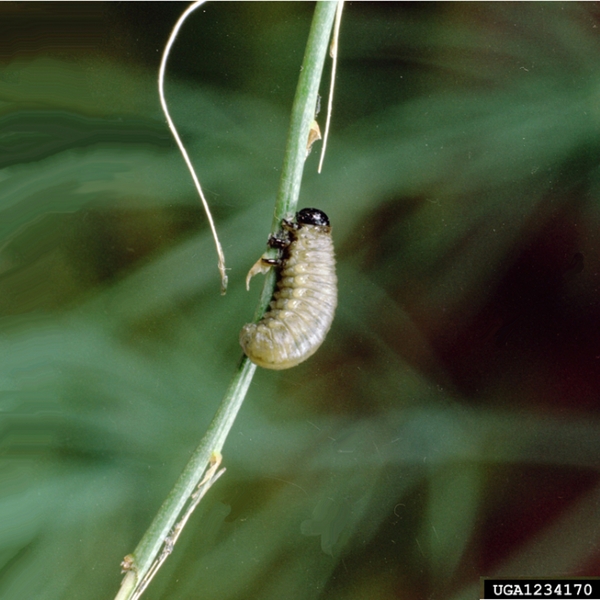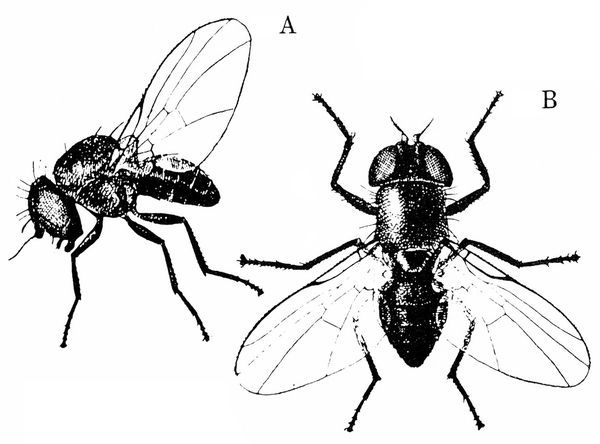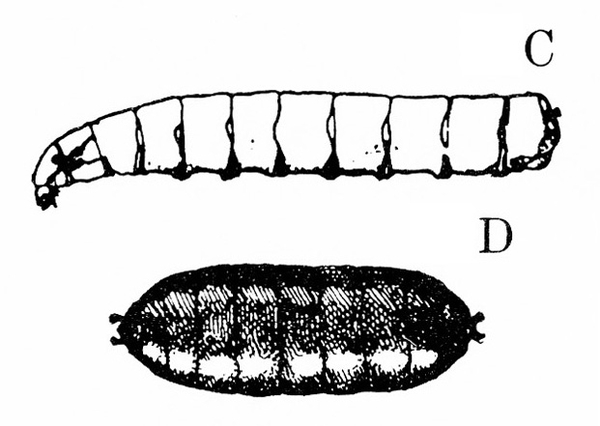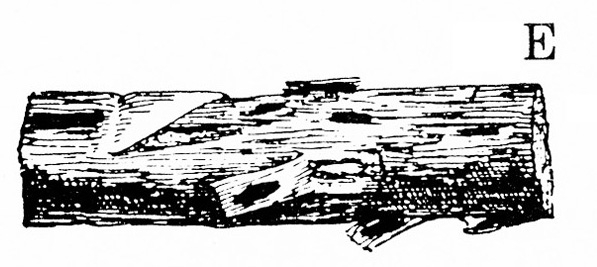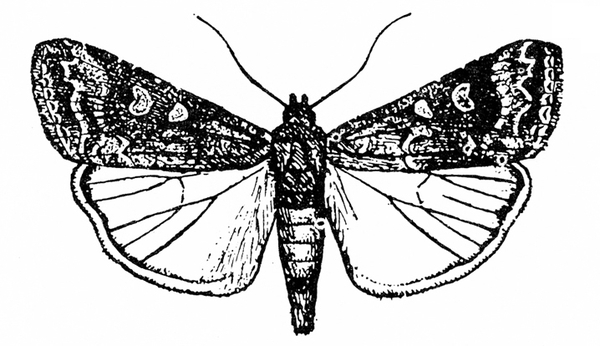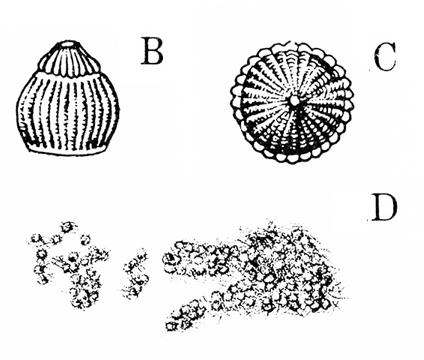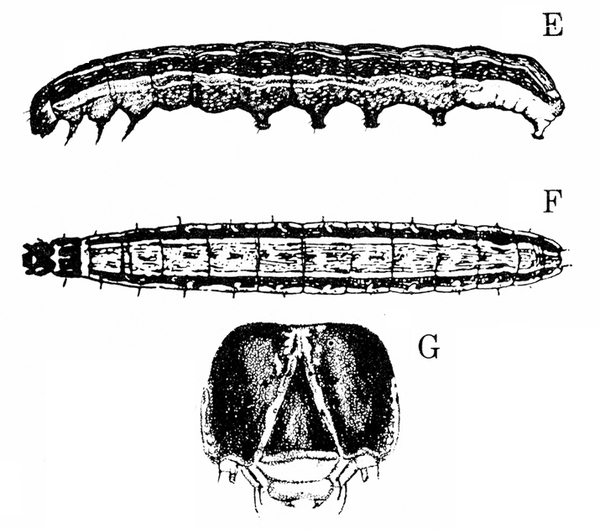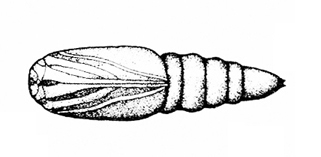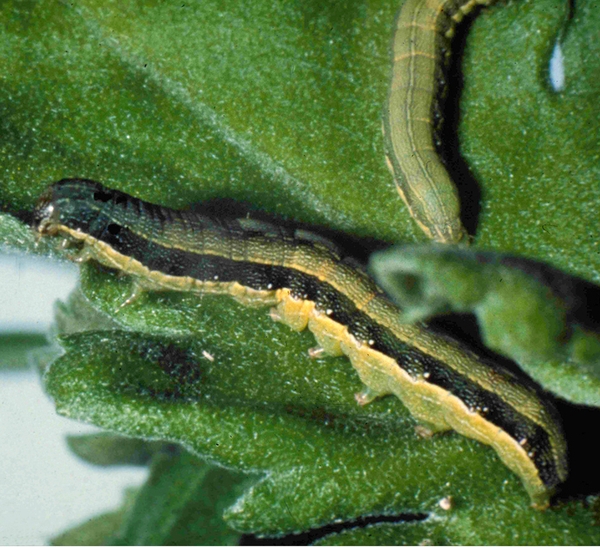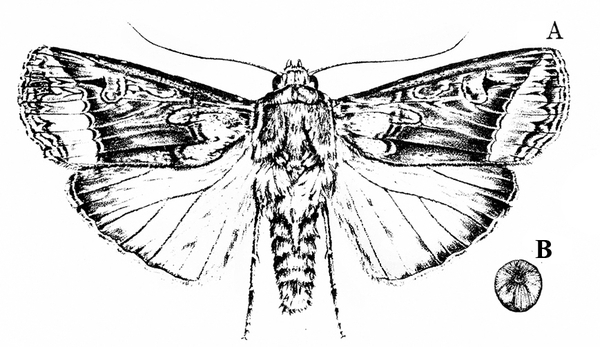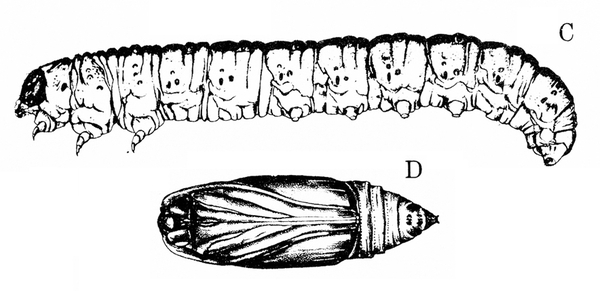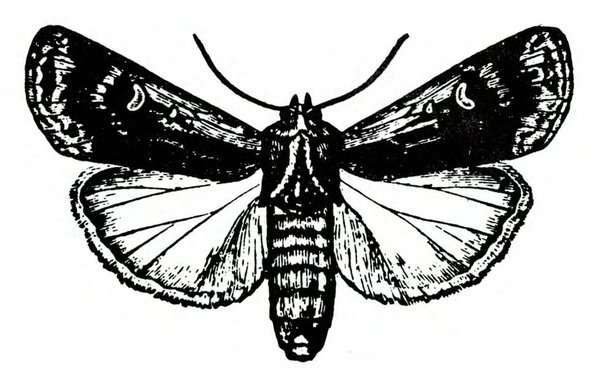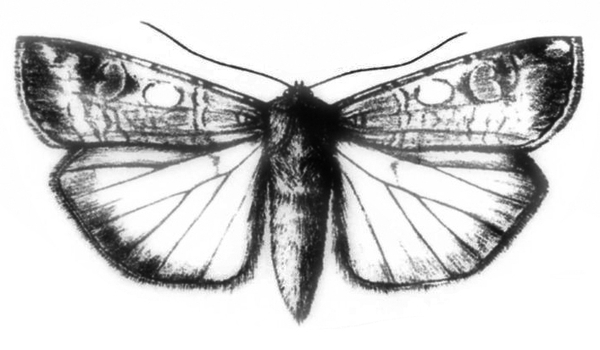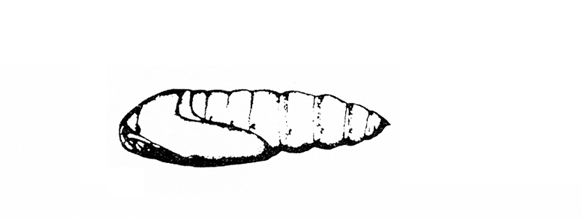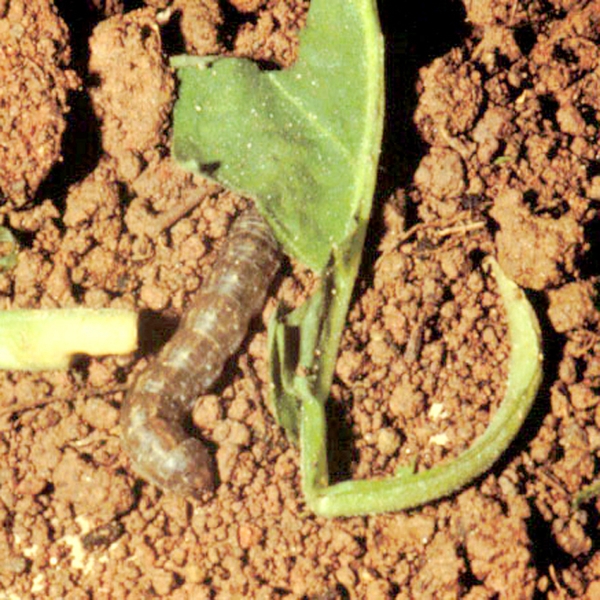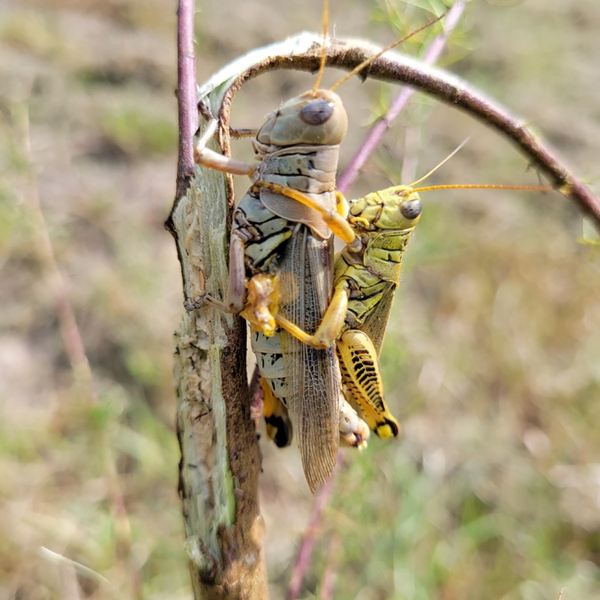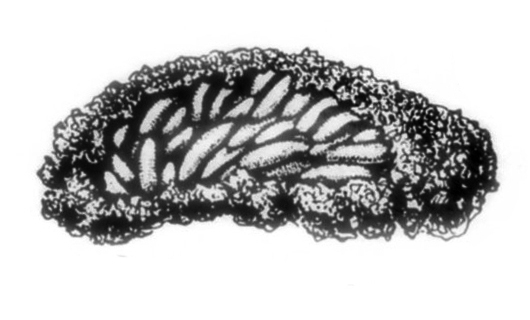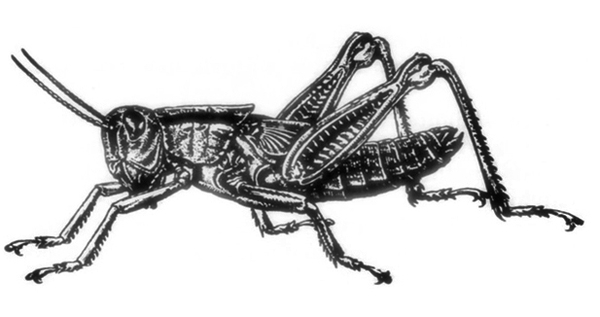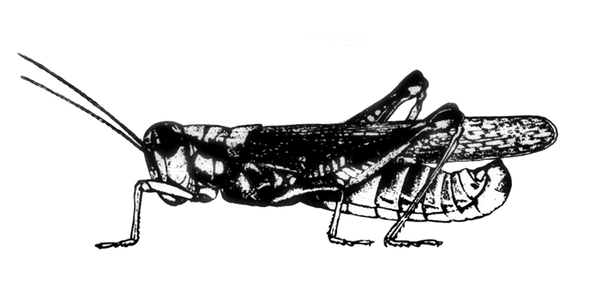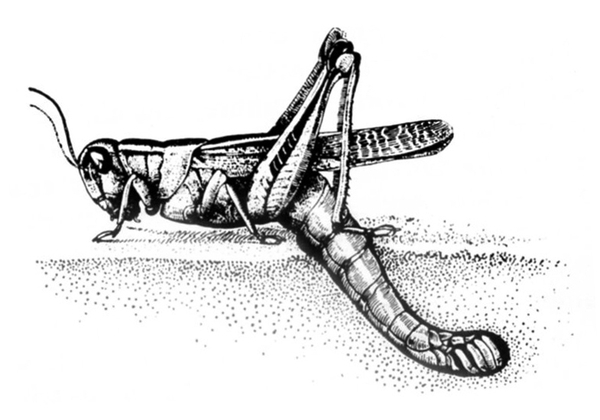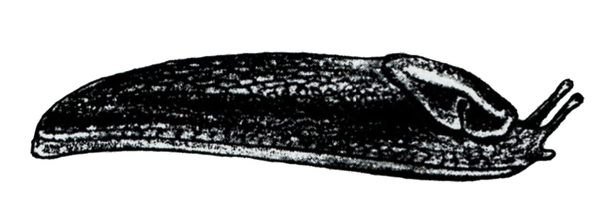Only about 1,000 acres are in commercial production in North Carolina, but asparagus is a popular crop in home gardens. One of the most expensive vegetables on the market, asparagus is a gourmet item. Asparagus has relatively few pests. Asparagus aphids, asparagus beetles, caterpillars, grasshoppers, and slugs damage plants.
-
Pests that feed on exposed berries, buds, shoots, or leaves
- Asparagus aphid—Pale green, powdery, and up to 3/32 inch long, asparagus aphids (Figure 1) feed on leaves and bracts, causing infested plants to become stunted or die.
- Asparagus beetles—These hard-bodied, chewing insects are smooth, shiny, and slightly elongate. The antennae are less than half the length of the body. The tarsi ("feet") appear four-segmented. The beetles feed on meaty, aboveground plant parts and leave brown scars on buds.
- Asparagus beetle (sometimes called common asparagus beetle)—This beetle has a metallic-blue head. The thorax is red with two blue spots. Each bluish-black wing cover has three yellowish square spots (Figure 2).
- Spotted asparagus beetle—This beetle is red-orange or tan with six black spots on each wing cover (Figure 3).
- Asparagus beetle grubs—These larvae are soft-bodied, plump, humpbacked, wrinkled, and sluggish. They grow to about 3/8 inch long and have three pairs of legs near the head and fleshy prolegs on most abdominal segments. They secrete a black fluid that stains the plant.
-
Beet armyworm—These caterpillars are 1 3/16 inches long, soft-bodied, and green to black, with three light-colored stripes running the length of the body. There is a black spot on each side of the body on the second segment behind the head. It has three pairs of legs and five pairs of prolegs (Figure 6). Beet armyworms damage buds, young leaves, and tender tips, causing the stalks to curl and become deformed.
-
Pests that feed on roots or lower stems and usually are hidden in the soil
- Beet armyworm—Beet armyworms usually feed on foliage but occasionally feed on roots or lower stems.
- Cutworms—Several species of fat, soft-bodied, basically gray, black, or brown cutworms feed on asparagus roots. They are 1 5/8 to 2 inches long when fully grown. Cutworms have three pairs of legs and five pairs of prolegs (Figure 7A, Figure 7B, and Figure 7C). Cutworms occasionally feed above ground on spears and ferns when young, but older larvae burrow in soil during the day and sever plant stems at night. They curl up when disturbed.
- Asparagus miner—These small maggots, as long as 3/16 inch, mine in the stems close to the ground (Figure 8), making the plant vulnerable to disease-causing organisms.
- Grasshoppers—Full-grown grasshoppers (Figure 9) are 3/4 to 1 5/16 inches long. They feed on spears and foliage, and gnaw and girdle asparagus stems.
- Slugs—Soft and slimy, slugs are about 2 to 4 inches long (Figure 10). They usually forage as temperatures fall and retreat as temperatures climb. Using their eversible tongues that are armed with thousands of microscopic teeth, slugs rasp pits and holes in spears and consume foliage.
Asparagus Aphid
Brachycorynella asparagi (Mordvilko), Aphididae, HEMIPTERA
Description
Adult—The powdery, pale-green asparagus aphid is 1/16 to 3/32 inch long (Figure 11A). Winged aphids are somewhat pear-shaped, soft-bodied insects with a pair of slightly raised bumps (cornicles) on top near the rear of the abdomen (Figure 11B). Wingless females are slightly more slender.
Egg—Eggs are pale when first laid but soon darken to shiny black (Figure 11C). They are slightly less than 1/32 inch long.
Nymph—Nymphs resemble wingless females, but young ones are much smaller (Figure 11D). Nymphs gradually grow to 1/16 inch long. Nymphs destined to have wings develop wing “pads” in their later stages.
Biology
Distribution—The asparagus aphid is native to eastern Europe and the Mediterranean area. The first infestation in North America was noticed in New York in 1969. Since that time, the aphid has been reported throughout the United States wherever asparagus is grown.
Host Plants—Asparagus is the only known food plant of this aphid.
Damage—Asparagus aphids feed on cladophylls (modified leaves) and under bracts, where they extract sap through their needlelike mouthparts. Heavily infested seedlings may form rosettes or shrivel and die. Similar infestations on older plants may cause severe dwarfing. Fortunately, predators, parasites, and diseases have kept this aphid from becoming a serious pest in most areas.
Life History—Male and female adults develop in September and October. After mating, females lay eggs on the lower portion of the ferns. Eggs hatch in the spring, developing through four nymphal stages. New females give birth to 55 additional female nymphs over 20 days. Nymphs mature eight to ten days later and begin to produce another generation of female nymphs soon after. During the growing season, some adult females develop wings and disperse to new hosts. The biology of the asparagus aphid has not been formally studied in North Carolina. Here, it probably overwinters as eggs. In spring, aphids hatch and resume development. Most species of aphids are prolific and produce live young without mating. New generations continue to be produced as long as warm, dry weather continues and host plants are available.
Control
Removing dead ferns during the fall or winter and tilling in spring often control this pest. Asparagus aphid populations are subject to least 31 species of natural enemies (predators, parasites, and diseases), so chemical control is rarely necessary. Should large aphid populations develop, consult your local Extension center or the North Carolina Agricultural Chemicals Manual. Treating the ferns twice with an insecticide, about 10 days apart, should provide effective control.
Asparagus Beetles
Asparagus beetle (also called common asparagus beetle), Crioceris asparagi (Linnaeus), Chrysomelidae, COLEOPTERA
Spotted asparagus beetle, Crioceris duodecimpunctata (Linnaeus), Chrysomelidae, COLEOPTERA
Description
Adult—About 1/4 to 3/8 inch long, asparagus beetles are smooth, shiny, and slightly elongate. The asparagus beetle has a metallic-blue head and bluish-black wing covers, each with three yellowish square spots and reddish outer margins (Figure 12A and Figure 13A). The area just behind the head is red-orange or tan. Spotted asparagus beetles are 3/16 to 5/16 inch long and are reddish orange with black spots on the forewings. The eyes and antennae are black, and the legs are orange with black spots at the joints (Figure 12F).
Egg—The dark-brown, bullet-shaped egg of the asparagus beetle is about 1/16 inch long and attached by one end to the host plant (Figure 12B). The spotted asparagus beetle egg is the same size but greenish and glued on its side to the host plant (Figure 12G).
Grub (larva)—The grubs of both species are plump, humpbacked, wrinkled, sluggish, and about 3/8 inch long when fully grown. The pale to dark-gray grub of the asparagus beetle has a black head and brown legs (Figure 12C–D and Figure 13B); the grub of the spotted asparagus beetle has an orange to brown head and brown legs. It varies from pale yellow when newly hatched to orange when mature (Figure 12H).
Pupa—Both species have a yellowish pupa about 5/16 inch long (Figure 12E) that is protected by a tough, silken cocoon embedded with soil particles.
Biology
Distribution—Both species of asparagus beetles occur throughout the United States and Canada wherever asparagus is grown.
Host Plants—Asparagus is the only food plant of these beetles.
Damage—Asparagus beetles may attack asparagus shoots as soon as they appear in spring. The beetles eat shoots and leaves but are particularly damaging when they gnaw the tips of buds, causing them to scar and turn brown (Figure 12I–J). In dry seasons, asparagus shoots may be blackened by hundreds of eggs from these beetles. The larvae of the asparagus beetle damage plants much like the adults do but also secrete a black fluid that stains the plant. Larvae of the spotted species, on the other hand, feed on developing berries, each larva often consuming three or four. Damage to the berries, however, is of little economic importance.
Life History—Asparagus beetles overwinter as adults in sheltered sites, particularly under bark or in stems of old plants. Asparagus beetles appear slightly earlier in spring than the spotted species. The beetles feed as soon as they emerge and begin laying eggs several days later. Eggs hatch in three to eight days, depending on temperature. For 10 to 14 days, larvae feed and develop through four instar stages. Fully grown larvae crawl to the ground and dig chambers in the soil. Within the chambers, they spin silken cocoons and pupate for five to ten days. Soon afterward, a new generation of beetles emerges. This three- to four-week cycle is typical in the summer. In fall or early spring, eight weeks may pass between the egg and adult stage. As many as five generations per year occur in North Carolina.
Control
Many beneficial insects feed on or parasitize the various life stages of asparagus beetles. Lady beetles and other predaceous beetles, soldier bugs, and certain small wasps, flies, and dragonflies may reduce asparagus beetle populations, though these beneficial insects often do not provide sufficient control.
In small gardens, it may be practical to knock larvae off plants and onto the soil. Dislodged larvae are usually unable to climb back onto the plant, and they die on the hot soil. Gathering and burning asparagus berries help lower and prevent additional infestations of spotted asparagus beetles.
Should populations of beetles become a problem, chemical controls are available. For up-to-date recommendations, consult the North Carolina Agricultural Chemicals Manual.
Asparagus Miner
Ophiomyia simplex (Loew), Agromyzidae, DIPTERA
Description
Adult—The shiny-black, slightly humpbacked asparagus miner fly is a little over 1/8 inch long (Figure 14A–B).
Egg—Inserted beneath the epidermis of an asparagus stalk, the egg is rarely seen. White at first, the almost 1/32-inch-long egg later assumes the color of asparagus tissue.
Larva (maggot)—When newly hatched, the miner is pure white and 1/64 inch long. The mature third instar has black, rasping mouthparts and may be as long as 3/16 inch (Figure 14C–D).
Puparium—The puparium is formed by the last shed larval skin, which forms a ridged covering within which the pupa develops. Dark brown, flattened, and up to 3/16 inch long, the puparium (Figure 14C–D) has many hooks that attach it firmly to the plant.
Biology
Distribution—The asparagus miner has been reported from southeastern Canada into Tennessee and North Carolina. It is also found in California, Hawaii, and Great Britain and other parts of Europe.
Host Plants—Asparagus and celery are the only known food plants of this insect.
Damage—Asparagus miners tunnel just below the surface of spears (Figure 14E), usually near the base of a plant. These insects were formerly believed to girdle plants, causing yellowing of foliage and premature death; those symptoms are now attributed to the disease-causing fungus Fusarium. It has not yet been determined whether heavy miner infestations predispose plants to this disease. Miners cause some tissue breakdown (brown streaks) that may render spears unmarketable, but they do not interfere with water or nutrient uptake and probably do not reduce yields. Seedlings and plants in newly set beds are most likely to become infested.
Life History—Biological studies on this insect have not been undertaken in North Carolina or other southern limits of its range. In New York, pupae within puparia overwinter in spears left in the field or 1 to 6 inches below the soil surface. Flies emerge in the latter half of May and mate. Oviposition begins one or two days later. The flies live only four or five days and produce only one batch of eggs. Eggs may be thrust into plant stems or deposited in the soil. After incubating 12 to 17 days, eggs hatch. Larvae feed beneath the epidermis of the stem and develop through three instars over two to three weeks. Before pupating, they usually mine toward the base of the plant. Pupation lasts 17 to 21 days, and new adults usually emerge in July. The life cycle is then repeated, with the last generation of pupae overwintering. Only two generations are produced each year in New York.
Control
Several wasps (Dacnusa rondani, Dacnusa bathyzona, Sphegigaster spp., and Pleurotropis epigonus) parasitize asparagus miner pupae and help reduce populations. Cultural practices such as pulling and destroying spears at the end of the season or in early spring significantly help eliminate the overwintering stage of asparagus miners. Chemical control is rarely necessary.
Beet Armyworm
Spodoptera exigua (Hübner), Noctuidae, LEPIDOPTERA
Description
Adult—The beet armyworm moth has a wingspan of 1 to 1 1/4 inches (Figure 15A). Its forewings are mottled gray or brown with a pale spot near the center of each wing. Its hind wings are white with dark veins and a fringe-like border.
Egg—The egg is almost 1/32 inch wide, white to pink, ribbed, and roughly spherical in shape but slightly peaked on top. Scales and hairs from the moth give the egg cluster a gray, fuzzy appearance (Figure 15B–D).
Larva—This green or black caterpillar has a dark head, three pairs of legs and five pairs of prolegs, and sometimes three light-colored stripes running the length of the body (Figure 16). On the second segment behind the head, there is a small, black spot on each side of the body. This spot usually becomes visible to the field observer when the caterpillar reaches 1/4 to 5/16 inch long; however, the spot may be difficult to see on a dark caterpillar. Almost 1/16 inch long when newly emerged, the larva may be 1 to 1 3/16 inches long when fully grown. Its face has a light, inverted V marking (Figure 15E–G).
Pupa—About 9/16 to 3/4 inch long, the pupa is light brown with dark-brown margins along the abdominal segments (Figure 15H).
Biology
Distribution—Native to Southeast Asia and introduced into this country around 1875, the beet armyworm is now common throughout the southern and western United States. It occurs northward into Montana.
Host Plants—The beet armyworm infests many weeds, trees, grasses, legumes, truck crops, and field crops. In various locales, it causes economic damage in asparagus, cotton, corn, soybean, tobacco, alfalfa, table and sugar beets, peppers, tomato, potato, onion, pea, sunflower, and citrus crops. Wild hosts, including plantain, lambsquarters, and redroot pigweed, also attract beet armyworms.
Damage—Early-instar beet armyworms most frequently damage the young terminal growth. Profuse silk webbing may give infested plants a shiny appearance. Later instars do not feed gregariously, and the production of webbing is discontinued.
Life History—In temperate areas such as Florida and California, beet armyworm moths may be found year-round. Farther north, these insects can survive the winter as pupae in the upper 2 3/8 inches of the soil. The extent of the overwintering distribution, however, has not been adequately studied. This insect is not believed to overwinter as far north as Kentucky or North Carolina. Vegetable crops in North Carolina apparently become infested by migrating moths. In spring, soon after mating, fertile females begin laying eggs in clusters of about 80. Each female can deposit about 600 eggs within three to seven days. Moths die four to ten days after emerging from pupae.
Eggs hatch in two to three days. The newly emerged larvae spin loose webs around themselves, feed gregariously on the remains of the egg mass, and then attack plant foliage. They eventually scatter to different parts of the plant. After feeding one to three weeks, larvae (fifth instars) pupate within loose cocoons composed of soil particles, leaf fragments, and trash. About a week later, moths emerge. The entire life cycle requires four to five weeks. Several generations occur each year.
Control
Beet armyworm have few parasites, diseases, or predators to lower their populations. Effective chemicals for beet armyworm control are available to the commercial vegetable producer or licensed applicator. Most chemicals cleared for home garden use will not control this pest adequately. For current recommendations, consult the North Carolina Agricultural Chemicals Manual.
Cutworms
Black cutworm, Agrotis ipsilon (Hufnagel), Noctuidae, LEPIDOPTERA
Granulate cutworm, Feltia subterranean (Fabricius), Noctuidae, LEPIDOPTERA
Variegated cutworm, Peridroma saucia (Hübner), Noctuidae, LEPIDOPTERA
Description
Adult—Black and variegated cutworm moths have wingspans of 1 1/2 to 2 inches. The forewings of black cutworm moths are dark with three black dashes and a white splotch near the tip of each wing (Figure 17A–B). Forewings of variegated cutworm moths are basically yellowish or light brown with pale, mottled designs (Figure 17G). Granulate cutworm moths have yellowish-brown forewings and a wingspan of 1 1/2 to 1 3/4 inches (Figure 17E). The hind wings of all three species are pale gray or off-white with dark veins.
Egg—The round eggs (Figure 17A–B and Figure 17H–I) have a diameter of almost 1/32 inch. White at first, they may become slightly darker before hatching. Cutworm moths lay eggs in masses, usually on foliage but sometimes on whatever surface is available.
Larva—Black cutworms are greasy-looking, gray to black caterpillars up to 1 13/16 inches long (Figure 17C–D and Figure 18). Granulate cutworms are dusty brown with rough, granulated skin and grow to 1 13/16 inches long (Figure 17F). Variegated cutworms are pale brown with a distinct yellow dot on each segment down the center of the back; they are about 2 inches long when mature (Figure 17J).
Pupa—Cutworm pupae (Figure 17C–D and Figure 17K) are about 3/4 inch long and dark brown or mahogany.
Biology
Distribution—Cutworms are cosmopolitan in their distribution and are common throughout most areas of Canada and the United States. The granulate cutworm, common in northern, central, and Gulf states, has a scattered distribution from North Carolina to Florida.
Host Plants—Most cutworms are general feeders that attack a wide range of plants. Besides asparagus, common vegetable hosts include bean, cabbage and other crucifers, carrot, celery, corn, lettuce, pea, pepper, potato, rhubarb, and tomato.
Damage—Young cutworms climb plants and feed on spears and ferns of asparagus. Mature cutworms, however, are sluggish, nocturnal, soil-burrowing organisms. They typically sever plant stems during the night (Figure 17L) and hide in soil near the bases of plants during the day.
Life History—Cutworms overwinter as larvae or pupae, depending on the species. In early spring, overwintering larvae of some species become active, feed, and complete their development. Moths emerge from overwintering pupae and lay eggs on host plants or other vegetation. Therefore, depending on the species, damaging cutworms found in spring may be overwintered larvae or new-generation cutworms. Cutworms develop through five to eight larval instar stages, depending upon the species.
Pupation occurs in the soil and lasts about two weeks during the growing season. Moths emerge and deposit 55 to several hundred eggs on host plants. The number of annual generations depends on latitude. Generally, there are two generations per year in Canada, four generations per year in North Carolina, and five to six generations per year in Florida.
Control
In small gardens, barriers around plants can prevent serious cutworm damage. By encircling individual plants with cardboard or metal "collars" pressed an inch into the soil, gardeners can create "fences" that cutworms cannot cross. Such a method, however, is not practical for large acreages. Should cutworms become a problem, contact your local Extension center or consult the North Carolina Agricultural Chemicals Manual for recommendations.
Grasshoppers
Differential grasshopper, Melanoplus differentialis (Thomas), Acrididae, ORTHOPTERA
Redlegged grasshopper, Melanoplus femurrubrum (DeGeer), Acrididae, ORTHOPTERA
Twostriped grasshopper, Melanoplus bivittatus (Say), Acrididae, ORTHOPTERA
Description
Adult—Full-grown grasshoppers are 3/4 to 1 1/2 inches long. The differential grasshopper is basically brownish yellow or olive green with contrasting black markings (Figure 19A). On the hind femur, these markings resemble chevrons. The redlegged grasshopper has a reddish-brown back, a yellow belly, and bright-red hind legs (Figure 19D). The twostriped grasshopper is greenish yellow with contrasting black or brown markings (Figure 19E). It has two light-colored stripes that run from the head to the tips of the wings.
Egg—Grasshopper eggs occur in oval, elongated, or curved pods (Figure 19B) made out of soil particles. Often the size of rice kernels, eggs may be white, yellow-green, tan, or various shades of brown.
Nymph—Newly hatched nymphs are white. After several hours of exposure to sunlight, they assume the distinctive colors and markings of adults (Figure 19C).
Biology
Distribution—Grasshoppers occur throughout the continental United States. The differential grasshopper is most injurious in the southern states. The redlegged grasshopper prefers areas of poorly drained soil. The twostriped grasshopper is common throughout North America.
Host Plants—The grasshoppers that damage crops are general feeders. Besides asparagus, they have been known to cause losses in small grains, corn, alfalfa, soybean, cotton, clover, grasses, and flax. The redlegged grasshopper prefers alfalfa.
Damage—Although about 600 species of grasshoppers occur in the United States, the differential, twostriped, and redlegged grasshoppers are among the most troublesome species in asparagus and forage crops. Differential and redlegged species are sporadically of economic concern in North Carolina forage crops and asparagus, but not every season. Damage is most severe in hot, dry weather.
Life History—The grasshopper species mentioned here overwinter as eggs in the soil. Eggs hatch throughout April, May, and June as soil temperatures rise and spring rains begin. The first nymph to leave the egg pod makes a tunnel from the pod to the soil surface through which the successive nymphs emerge. Nymphs feed and grow for 35 to 50 days, molting five or six times during this period. Development proceeds most rapidly when the weather is warm and not too wet. Mature grasshoppers mate and continue feeding on crop plants. About two weeks later, females begin to deposit clusters of eggs in the soil. During this process, they secrete a glue-like substance that cements soil particles around the egg mass, forming a protective pod. Each pod may contain 25 to 150 eggs, depending on the species of grasshopper. Grasshoppers that deposit masses containing few eggs usually produce more pods to compensate. Typically, each female produces 300 eggs. Swarms of grasshoppers usually adopt a specific area as their breeding ground and lay all eggs in that vicinity. Most economically significant grasshopper pests complete only one generation each year. Redlegged grasshoppers, however, have at least two annual generations in North Carolina.
Control
Although grasshopper populations occur annually in North Carolina asparagus, infestations are not usually large enough to warrant control. Should populations become damaging, chemical recommendations are available in the North Carolina Agricultural Chemicals Manual.
Slugs
Brown slug (also called marsh slug or smooth slug), Deroceras laeve (Müller), Limacidae, STYLOMMATOPHORA
Garden slug (also called black field slug), Arion hortensis Férussac, Arionidae, STYLOMMATOPHORA
Gray garden slug (also called netted slug or gray field slug), Deroceras reticulatum (O.F. Müller), Limacidae, STYLOMMATOPHORA
Greenhouse slug, Milax gagates (Draparnaud), Limacidae, STYLOMMATOPHORA
Lehmannia slug, Lehmannia poirieri (Mabille)(= Limax marginatus of Pilsbry), Limacidae, STYLOMMATOPHORA
Spotted garden slug (also called leopard slug), Limax maximus, Limacidae, STYLOMMATOPHORA
Description
Adults—Arion slugs (Figure 20A), which include the garden slug, can grow to 1 1/4 inches long. They breathe via a pore located in the anterior half of the mantle (in all other pest slugs, the breathing pore is in the posterior half of the mantle); the back is never keeled; and the posterior end appears rounded when viewed from above. Arion slugs can eat 56 percent of their body weight in one day.
Brown slugs (Figure 20B) grow to about 1 inch long and are light gray to blackish brown with a breathing pore surrounded by a pale ring. They exude clear, watery mucus when irritated.
Gray garden slugs (Figure 20C) grow to 2 inches long and lack stripes. Their breathing pore is surrounded by a pale ring. They exude sticky, milky slime when irritated.
The greenhouse slug (Figure 20D) has a strongly keeled back from the mantle to tip of the tail. This slug grows to 2 3/4 inches long. The mantle is grainy, with the center part bound by a groove (in other pest slugs, the back is keeled only near the posterior end, if at all). The mantle of the greenhouse slug is wrinkled in concentric circles, without a groove. It usually burrows in the soil and feeds on roots.
Lehmannia slugs (Figure 20E) are 2 1/2 inches long, have well-defined dark stripes, and the breathing pore is not surrounded by a pale ring. They exude watery slime when irritated.
The spotted garden slug (Figure 20F) has black spots on the mantle and body and grows to 4 inches long, although it can stretch its body to 8 inches long.
Eggs—Slug eggs are spherical and clear when first laid in groups.
Young—The young resemble adults, but are smaller.
Biology
Distribution—All of our pest slugs are nonnative and are found throughout the Northern Hemisphere except the arid southwestern United States and other desert areas.
Host Plants—Slugs feed on almost any young, tender plant and also algae and molds.
Damage—Slugs may eat up to 40 percent of their body weight per day. They may completely consume small seedlings and riddle larger plants with holes. Slime trails are often observed near and on damaged plants.
Life History—As a young slug matures, it becomes a male. Later it develops female parts and may become a true hermaphrodite capable of self-fertilization. Older slugs are females that mate with males. Eggs are laid in sheltered locations, sometimes in groups, to prevent desiccation. Some slugs produce hundreds of eggs. Slugs tend to forage whenever temperatures are falling and seek shelter as temperatures rise. Some Deroceras slugs forage late in fall and resume activity in late winter and very early spring. They continue to forage even when temperatures approach 32ºF. Slugs often hibernate in clusters, usually underground, especially in dry weather and during the coldest portion of winter. Spotted garden slugs have the tendency to eat smaller slugs, including other spotted garden slugs. Slugs are plagued by diseases, parasites, and predators, including birds and deer.
Control
Bait containing metaldehyde and carbaryl can be effective in controlling slugs. Metaldehyde causes slugs to dehydrate, but if an affected slug has access to water, it may survive. Carbaryl and other carbamate baits, on the other hand, become even more toxic if the affected slug can get to water. For best control, apply the molluscicide on a warm, clear night under boards or other traps. Some gardeners have been known to kill slugs with table salt, but salt is toxic to plants (although asparagus seems to be more tolerant of salt than most plants). Because copper repels slugs, copper strips may be used as barriers. Iron phosphate is another relatively safe molluscicide that is available in most big box stores, plant centers, and nurseries. It causes slugs and snails to cease feeding, seek shelter, and die within a few days. Two or more treatments of iron phosphate applied at five- to seven-day intervals may be necessary to obtain adequate control.
Other Resources
General
Drake, C. J., and H. M. Harris. Asparagus Insects in Iowa. Circular 134. Iowa Agriculture Experiment Station, 1932.
Putnam, A. R., et al. Know Your Asparagus Pests. Bulletin E-959. Michigan State University Cooperative Extension Service, 1976.
USDA. Commercial Growing of Asparagus. Farmers' Bulletin 2232. USDA, 1975.
Asparagus Aphid
Angalet, G. W., and N. A. Stevens. “The Natural Enemies of Brachycolus asparagi in New Jersey and Delaware.” Environmental Entomology 6, no. 1 (1977): 97–100.
Boucher, T. J. "Asparagus Aphid: Brachycorynella asparagi.” The University of Connecticut, College of Agriculture, Health, and Natural Resources, 2012.
Capinera, J. L. “Damage to Asparagus Seedlings by Brachycolus asparagi.” Journal of Economic Entomology 67 (1974): 447–48.
U.S. Department of Agriculture, Plant Pest Control Division. “A New Aphid on Asparagus (Brachycolus asparagi).” FAO Plant Protection Bulletin 18 (1970): 93.
Asparagus Beetles
Capinera, J. L., and J. H. Lilly. “Bionomics and Biotic Control of the Asparagus Beetle, Crioceris asparagi, in Western Massachusetts.” Environmental Entomology 4, no. 1 (1975): 93–96.
Chittenden, F. H. The Asparagus Beetles and Their Control. Farmers' Bulletin 837. USDA, 1917.
Morrison, W.R., III, and Z. Szendrei. “The Common Asparagus Beetle and Spotted Asparagus Beetle (Coleoptera: Chrysomelidae): Identification, Ecology, and Management.” Journal of Integrated Pest Management 5, no. 3 (2014): B1–B6.
Taylor, R. G., and D. G. Harcourt. “The Distributional Pattern of Crioceris asparagi (L.) (Coleoptera: Chrysomelidae) on Asparagus.” Proceedings of the Entomological Society of Ontario 105 (November 1975): 22–28.
Asparagus Miner
Barnes, H. F. The Asparagus Miner (Melanagromyza simplex H. Loew). Circular No. 135. Washington, DC: U.S. Department of Agriculture, Bureau of Entomology, 1937.
Chittenden, F. H. The Asparagus Miner (Agromyza simplex Loew). Circular No. 135. Washington, DC: U.S. Department of Agriculture, Bureau of Entomology, 1911.
Eichmann, R. D. “Asparagus Miner Really Not a Pest.” Journal of Economic Entomology 36, no. 6 (1943): 849–52.
Fink, D. E., and G. W. Herrick. “The Asparagus Miner and the Twelve-Spotted Asparagus Beetle.” Cornell University Agricultural Experiment Station Bulletin 331 (1913): 410–21.
Spencer, K. A. Agromyzidae (Diptera) of Economic Importance. Series Entomologica 9. Berlin: Springer Dordrecht, 1973
Beet Armyworm
Atkins, E. L. “The Beet Armyworm, Spodoptera exigua, An Economic Pest of Citrus in California.” Journal of Economic Entomology 53, no. 4 (1960): 616–19.
Campbell, R. E., and V. Duran. “Notes on the Sugar-Beet Armyworm in California.” California Department of Agriculture Monthly Bulletin 18 (1929): 267–75.
Capinera, J. L. Common Name: Beet Armyworm, Scientific Name: Spodoptera exigua (Hübner) (Insecta: Lepidoptera: Noctuidae). Featured Creatures. Publication Number EENY–105. Entomology and Nematology, FDACS/DPI, EDIS, University of Florida, 2017.
Harding, J. A. “Heliothis spp.: Parasitism and Parasites Plus Host Plants and Parasites of the Beet Armyworm, Diamondback Moth and Two Tortricids in the Lower Rio Grande Valley of Texas.” Environmental Entomology 5 (1976): 669–671.
Hofmaster, R. N. “The Beet Armyworm: Present Control Status and Possible New Insecticides.” Vegetable Growers News 32, no. 12 (1978): 2–3.
Rabb, R. L. “Migration by Spodoptera exigua and S. frugiperda, North American Style.” In Movement of Highly Mobile Insects: Concepts and Methodology in Research; Proceedings of a Conference "Movement of Selected Species of Lepidoptera in the Southeastern United States," Raleigh, NC, April 9–11, 1979, edited by E. R. Mitchell and G. G. Kennedy, 386–93. Raleigh, NC: NC State University, 1979.
Todd, E. L. “New Distributional Records for the Beet Armyworm, Spodoptera exigua (Hübner) (Lepidoptera: Noctuidae).” USDA Cooperative Economic Insect Report 15, nos. 1–5 (1975): 14.
Wilson, J. W. The Asparagus Caterpillar: Its Life History and Control. Bulletin 271. Florida Agricultural Experiment Station, 1934.
Cutworms
Busching, M. K., and F. T. Turpin. “Oviposition Preferences of Black Cutworm Moths Among Various Crop Plants, Weeds, and Plant Debris.” Journal of Economic Entomology 69 (1976): 587–90.
Harris, C. R., et al. “The Life History of the Black Cutworm, Agrotis ipsilon (Hufnagel), under Controlled Conditions.” The Canadian Entomologist 94 (1962): 1183–87.
Rings, R. W., and B. A. Johnson. An Annotated Bibliography of the Spotted Cutworm Amathes C-nigrum (Linnaeus). Research Circular 235. Ohio Agricultural Research and Development Center, 1977.
Rings, R. W., et al. A Worldwide, Annotated Bibliography of the Black Cutworm, Agrotis ipsilon (Hufnagel). Research Circular 198. Ohio Agricultural Research and Development Center, 1974.
Rings, R. W., et al. A Worldwide, Annotated Bibliography of the Variegated Cutworm, Peridroma saucia Hübner. Research Circular 219. Ohio Agricultural Research and Development Center, 1974.
Wadley, F. M. “Life History of the Variegated Cutworm.” Journal of Economic Entomology 14 (1921): 272–77.
Grasshoppers
Parker, J. R., and R. V. Connin. Grasshoppers: Their Habits and Damage. Agriculture Information Bulletin No. 287. Washington, DC: USDA, 1964.
USDA Agricultural Research Service. Grasshopper Control. Farmers' Bulletin 2193. Washington, DC: U.S. Department of Agriculture, 1977.
Slugs
Armstrong, J. H. “Frequently Asked Questions about Iron Phosphate for Controlling Snails.” FDACS-P-01991. Florida Department of Agriculture and Consumer Services, 2022.
Baker, J. R., ed. Insect and Related Pests of Flowers and Foliage Plants. AG-136. Raleigh, NC: North Carolina Cooperative Extension Service, 1994.
Dainton, B. H. “The Activity of Slugs, I. The Induction of Activity by Changing Temperatures.” Journal of Experimental Biology 31, no. 2 (1954): 165–87.
Nixon, P. “Slugs.” Home, Yard and Garden Pest Newsletter. College of Agricultural, Consumer and Environmental Sciences, University of Illinois at Urbana-Champaign, Illinois Natural History Survey, n.d.
Rollo, C. D., and W. G. Wellington. “Intra- and Inter-specific Agonistic Behavior among Terrestrial Slugs (Pulmonata: Stylommatophora).” Canadian Journal of Zoology 57, no. 4 (1979): 846–55.
Publication date: June 3, 2024
AG-295
Other Publications in Insect and Related Pests of Vegetables
Recommendations for the use of agricultural chemicals are included in this publication as a convenience to the reader. The use of brand names and any mention or listing of commercial products or services in this publication does not imply endorsement by NC State University or N.C. A&T State University nor discrimination against similar products or services not mentioned. Individuals who use agricultural chemicals are responsible for ensuring that the intended use complies with current regulations and conforms to the product label. Be sure to obtain current information about usage regulations and examine a current product label before applying any chemical. For assistance, contact your local N.C. Cooperative Extension county center.
N.C. Cooperative Extension prohibits discrimination and harassment regardless of age, color, disability, family and marital status, gender identity, national origin, political beliefs, race, religion, sex (including pregnancy), sexual orientation and veteran status.

